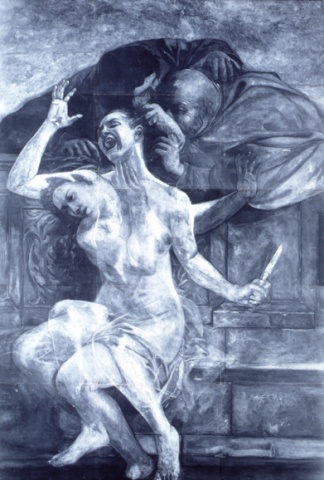Installations
Artemisia Gentileschi is considered an icon of feminist art, both because of her personal travails and the themes of her artwork. Gilje’s installation (at the National Museum of Women in the Arts) comprises a meticulous copy of Gentileschi’s 1610 painting Susanna and The Elders alongside an x-ray of the underpainting, a common practice in Gentileschi’s time of painting over sections of the canvas to make changes. Gilje created her underpainting to highlight how closely Gentileschi’s own story mirrors that of her chosen subject. Both the biblical character and the artist were subjected to unwanted attention from older men.
Susanna and The Elders was painted near the time that a charge of rape was brought to court by Gentileschi’s father, also a painter, on her behalf. The seven-month trial produced evidence of sexual harassment and rape of the 19-year-old artist by her teacher, Agostino Tassi, a member of her father’s artistic circle. Similarly, in the bible story, Susanna declines the sexual advances of two elder men in her community. Shamed by her refusal, they determine to ruin her reputation rather than their own. In the end, conflicting court testimony by the men proves her innocence.
Gentileschi’s Susanna and the Elders is an unusually sympathetic portrayal of a young woman defensive before her aggressors. It contrasts with treatments of the subject by male artists of the time, who most often portrayed Susanna as voluptuous and participating in the elders’ desire. What the x-ray reveals in Gilje’s Susanna and The Elders, Restored is an anguished but defiant Susanna, wielding a knife against her assailants. The knife, Gentileschi’s court-reported weapon of self-defense, transforms Susanna from victim to avenger. Gilje’s additions to the underpainting, motivated by biographical and historical information, seek the psychological reality behind the work.
